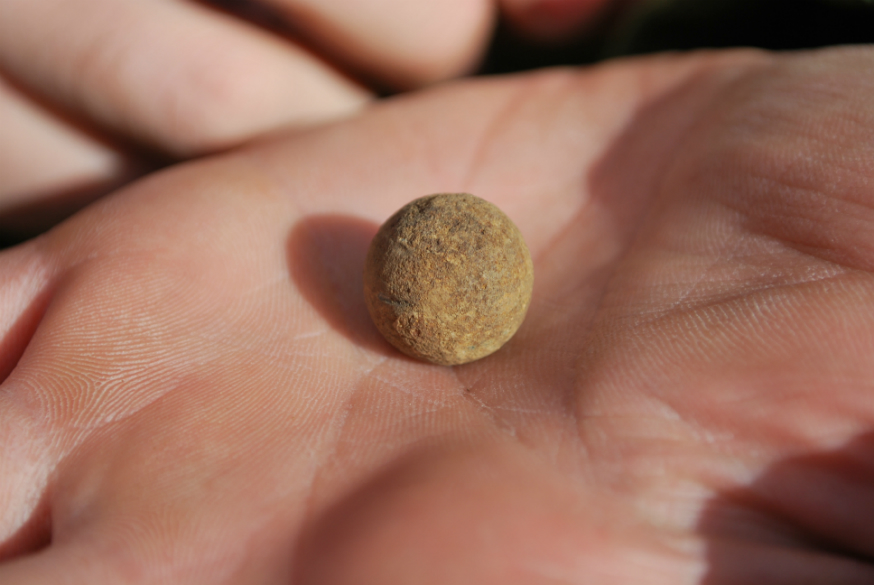|
You are viewing ARCHIVED content published online before January 20, 2025.
Please note that this content is NOT UPDATED, and links may not work. For current information,
visit https://www.nps.gov/aboutus/news/index.htm.

NPS
Contact: Nancy Nelson, 978-318-7811 Contact: Robert Morris, (978) 318-7822 Contact: Phil Lupsiewicz, 978-318-7833 Concord, MA. – The Friends of Minute Man National Park today released the final archaeology report on the Parker’s Revenge battle – the April 19, 1775, encounter in which Lexington’s Captain John Parker engaged the British Regulars on their march back from Concord to Boston.
“In this centennial year of the National Park Service, it is wonderful to be able to reveal “new” history tied to the opening of the American Revolution,” said Nancy Nelson, superintendent of Minute Man National Historical Park. The 320-page report summarizes historical research on the battle, details the full range of technologies deployed in the archaeological research and describes battle tactics likely utilized by both colonial and British forces. The project findings are noteworthy, especially because only one brief witness account the battle has ever been identified by historians. Technologies utilized in the research informed formal excavations and 1775 battlefield reconstructions. These methods included: 3D laser scanning, GPS feature mapping, and geophysical surveys including metallic surveys, ground penetrating radar, magnetic gradient and conductivity/magnetic susceptibility. Taken together, the technologies enabled researchers to locate a farmhouse that figured prominently in the battle terrain, to recreate the actual 1775 battlefield landscape and battlefield features and even to model exactly what combatants could and could not see at various positions along the battle road. Artifacts discovered included 29 British and colonial musket balls from the battle. The location and spatial patterning of the musket balls recovered enabled archaeologists to interpret the exact positions where individuals were standing during the battle — and then outline battle tactics most likely deployed. “Using an integrated approach to interpreting this battlefield enabled us to literally peel back time and expose the artifacts that tell the story of Parker’s Revenge,” said Project archaeologist Dr. Meg Watters. The report indicates that Captain Parker positioned his men at the edge of a wood lot on an elevated slope above the battle road. This particular site had two distinct advantages: it provided a clear view to see the advancing British forces and the landscape featured a number of large boulders and trees that provided cover. A viewshed is an area that is visible from one specific location in a landscape. Archaeologists ran a computer simulated viewshed analysis taken from the perspective of a 5’5”-tall marching British soldier and also from the point of view of a mounted British officer (9 feet above ground). The analysis indicated that the undulating terrain surface, combined with other obstacles, meant the British force could not easily see the position of the Lexington militia until it was in close proximity. The report further details the likeliest battle scenario. After crossing the Nelson Bridge and catching sight of the Lexington militia, a British vanguard unit fanned out to the left and was given orders to deploy into flanking formation using a designated point or feature in the landscape as an end target. Closely spaced, these soldiers made an excellent target for the Lexington militia. Before the British unit could complete its deployment, the Lexington militia fired from a position of not more than 40 yards away. Once they completed their deployment, the British Regulars returned fire on the retreating colonial milita. Cognizant of the British tactic to follow firing with a bayonet charge, the Lexington militia withdrew in a line along the middle contour of a slope to the northeast then disappeared over the top behind the protection of a ledge outcrop to continue the fight further down the road. “With the archaeology portion of the project now complete, we will turn our attention to the next two phases of the Parker’s Revenge initiative – rehabilitation of the battlefield and the creation of educational resources for park visitors,” said Bob Morris, president of the Friends of Minute Man National Park. ”We need to raise additional funds to complete those two key phases of the project.” The Parker’s Revenge project is a collaborative venture between the Friends of Minute Man National Historical Park, Minute Man National Historical Park, the National Park Service Northeast Regional Archaeology Program, the Town of Lexington’s Community Preservation Fund, the Lexington Minute Men and other living history experts, Save Our Heritage, the Civil War Trust’s Campaign 1776 project, the American Revolution Institute of the Society of the Cincinnati and numerous local supporters. About the Friends of Minute Man The non-profit Friends of Minute Man National Park supports the national park by funding educational programs and raising funds for restoration and preservation. For more information about the Parker’s Revenge project and the Friends of Minute Man National Park or to view a copy of the archaeology report, visit http://www.friendsofminuteman.org |
Last updated: November 30, 2021
